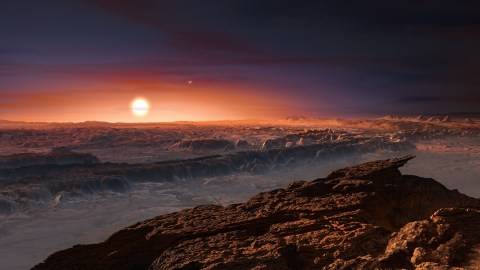35% of all known exoplanets are ‘water worlds’, researchers find

Do atmospheres of steam, with oceans of liquid water, and ice-encrusted rocks sound like the kind of planet you’d expect anywhere but here?
Turns out, after scientists studied 4,000 known exoplanets (a planet surrounding a star outside of our solar system), fully one-third of them—or 1,400 of those 4,000—were found to be water-rich worlds. In some cases, as much as 50% of the weight of the planets is water. (By comparison, the Earth is only 0.02 per cent water weight.)
“It was a huge surprise to realize that there must be so many water-worlds,” said lead researcher Dr Li Zeng of Harvard University.

A hand out image made available by the European Southern Observatory on August 24 2016, shows an artist’s impression of a view of the surface of the planet Proxima b orbiting the red dwarf star Proxima Centauri, the closest star to the Solar System. (Photo credit M. KORNMESSER/AFP/Getty Images)
Water of some kind means they could have life on them … but perhaps not anything we’ve conceived of before.
“This is water, but not as commonly found here on Earth,” said Li Zeng. “Their surface temperature is expected to be in the 200 to 500 degree Celsius range. Their surface may be shrouded in a water-vapor-dominated atmosphere, with a liquid water layer underneath.
Li Zeng continued, “Our data indicate that about 35% of all known exoplanets which are bigger than Earth should be water-rich. These water worlds likely formed in similar ways to the giant planet cores (Jupiter, Saturn, Uranus, Neptune) which we find in our own solar system.”
Interestingly, all of the planets studied ended up being 1.5 to 2.5 times the size of Earth. And there’s a correlation between the sizes; using their models, it turns out that planets 1.5 times the size of the Earth are very likely to be rocky, and 2.5 times our size, water worlds.

The paper and research, presented at the Goldschmidt Conference in Boston this week, confirms what has long been suspected: We’re not the only water-rich world out there.
Scientists used the Kepler Space Telescope, specifically designed to hunt for exoplanets, and the Gaia mission to find these planets, but two new tools will soon be available to dig much deeper.
Li Zeng continued. “The newly-launched TESS mission will find many more of them, with the help of ground-based spectroscopic follow-up. The next generation space telescope, the James Webb Space Telescope, will hopefully characterize the atmosphere of some of them. This is an exciting time for those interested in these remote worlds.”
TESS (Transiting Exoplanet Survey Satellite) was launched in April, 2018, and the James Webb Space Telescope is due to be launched in 2021.





